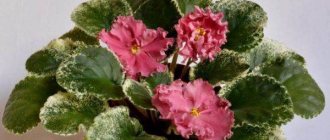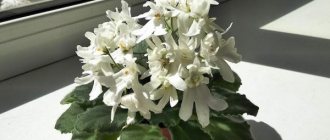Horned violet is a true gardener's find. For more than 450 species and varieties of this plant characterized by unpretentiousness and long flowering, which makes its cultivation easy even for novice florists.
With proper care, this flower will become a real decoration of the garden.
Let's find out in more detail what the perennial horned violet looks like - varieties and description.
Horned violet
The scientific name of this flower is Viola cornuta . It is this natural species that is most often meant when it comes to horned violet.
It is a representative of the large violet family, which was introduced into cultivation in the second half of the 18th century.
general information
This name includes both the perennial street violet (V. cornuta) and the varieties bred on its basis, as well as numerous hybrids . For a number of characteristics, they often differ significantly from the natural species, especially in winter hardiness.
Varietal violets live in flower beds as perennials and can withstand frosts down to -25℃, while hybrids are more susceptible to unfavorable conditions and are often grown as annuals or biennials.
You can see a photo of the perennial horned violet on the right.
Growing in nature
The natural habitat of viola is the mountainous terrain of Spain and France.
Morphological description
Horned violet is a herbaceous perennial of the Violet family. Depending on the variety, the bush grows up to 10-25 cm in height. As they grow, the stems intertwine and form dense cushions.
Leaves:
- Simple;
- Dark green color;
- Oval shape;
- Pointed.
The flowers are solitary on a long stalk and are characterized by a delicate aroma . The diameter of the corolla depends on the variety and ranges from 2 to 5 cm. Petal color:
- White;
- Yellow;
- And the whole spectrum from blue to violet tones.
There is a bright yellow spot in the center of the flower. On the reverse side of the corolla there is an elongated process similar to a horn.
The fruit is a single-locular capsule.
Important! Some hybrid forms of violet do not have a horned spur.
All varieties and hybrids obtained from this species have a number of advantages :
- Wide range of petal colors;
- Early onset of flowering, which begins in April-May;
- Long flowering - from May to September;
- Resistance to cold;
- Stable immunity to phytopathogens.
Horned violet hybrids have other advantages.
Garden forms are represented by simple and ampelous varieties.
Features of the root system
The plant has a branched rhizome - a modified underground stem, thanks to which it actively grows.
Just a few bushes in a year can form a dense cushion with an area of 2 m2. Each can bear up to several dozen flowers.
The roots of the horned violet are actively growing.
Description
The height of this variety does not exceed twenty-five centimeters.
- The flowers of the plant are delicate with an exquisite aroma. They are small in size, about five millimeters in diameter.
- Their petals have an elongated shape. The inflorescences grow singly and give the bush the appearance of a pillow. Over time, the violet grows and the flowers become a carpet.
- The Horned Violet gets its name from its appendage at the back. It resembles a horn in appearance. The varieties that have recently begun to renew no longer have such a shoot.
The cultivation of horned violets began in 1776. The roots have many branches and the ability to spread. This plant grows and reproduces well.
Several planted bushes will turn into a flower garden with an area of two square meters in a year. Each of them can grow up to sixty inflorescences.
The flowers grow on long stems. In the center of the inflorescence there is an eye that has an orange tint. The oval leaves are dark green with large teeth along the edge. Horned violet can have different colors of its inflorescences.
They can be:
- soft purple
- yellow,
- orange,
- burgundy.
Some types of plants can grow with monochromatic flowers. Landscape designers prefer them for recreating flower beds. There are varieties in which one bush can have several colors at once.
The ability to bloom for a long time is an advantage of the horned violet. From May until September, the flowers do not disappear from the plant. The first inflorescences that appear in the spring are usually more magnificent than all the others.
On hot days, violets cannot have large flowers. By autumn her abilities are restored.
Advantages:
- Various shades of inflorescences;
- Blooms early and long;
- Not afraid of cold weather;
- Almost never gets sick.
Landscape design
The small flowers of the plant do not give a beautiful appearance if planted separately. Therefore, professional designers, to give a general look, try to plant violets in groups (several bushes nearby). They are small in height, so they are always placed at the front of the flower bed.
Bright inflorescences look organic:
- In the flower beds;
- In mixborders;
- On the alpine slides;
- In curb areas.
The small size of the bush can be used for decoration on the balcony.
Ideal neighbors for the horned violet in the front garden can be:
- Coniferous plants in the form of shrubs or trees. They shade the violet with their size. This protects it from direct sunlight. A carpet of flowers under coniferous bushes gives the flower garden an aesthetic appearance.
- Ferns or hostas.
- Flowers you can plant: tulips, daffodils, hyacinths.
Varieties of horned violet
The plant can be crossed well with other species. Breeders have created many hybrids of horned violet. But their properties are already different from the original form. Their leaves have sharp teeth and are oval in shape.
The bushes can grow into a mat and remain in this state throughout the flowering period. And some hybrids stretch out their shoots. This requires constant pruning.
Flower growers divide into two groups of varieties:
- Horned violet;
- Hybrid horned violet.
Care and cultivation depends on the plant variety. The rules may vary. Hybrids tolerate cold worse. Therefore, she must be protected from them. And some violets are biennial bushes.
Growing in open ground
The perennial bicorn violet is quite unpretentious , but in order for it to feel good, it is necessary to create comfortable conditions for it.
How to choose a landing site?
Viola prefers moderate temperatures , so it is better to plant it in partial shade or next to larger plants that can protect the violet from overheating.
Attention! Too much shading promotes stagnation of moisture and can provoke an attack by slugs on violets.
In addition, the area should be well ventilated .
What soils does the plant prefer?
For abundant flowering of viola, the soil must be of the required quality:
- The most suitable is loamy, well-drained soil with an acidity of 6.5-7.2;
- To avoid stagnation of water, you can prepare a substrate from a mixture of humus and loam;
- The soil surface is mulched with wood chips, tree bark, etc. to retain moisture.
Watering and fertilizing
Viola needs to be well watered and fed a little, which is determined by the quality of the soil. Fertilize the soil no more than twice a year:
- In the spring, when the violet begins to grow, and at the end - after the end of flowering;
- It is optimal to use mineral or organic fertilizer containing a complex of microelements.
Important! The exception is fresh manure, which is destructive for violets.
Planting rejuvenation, pruning, decorative support
To maintain an impeccable appearance of the flower bed, it is recommended to replant young violets . This update will go completely unnoticed.
To rejuvenate the bush, it is necessary to replant young shoots.
To maintain the beauty of the bushes, peduncles with seed pods are removed at the end of the season.
Preparing for winter
Horned viola is characterized by high resistance to low temperatures . In many regions of Russia, it winters right in the flowerbed. To do this, just place spruce branches or sawdust on top of the flowers.
Varieties
There are a large number of varieties of horned violets, which are distinguished by a variety of colors.
"Doll." This variety will feel great in the garden. The bush grows up to 10 centimeters in height. It is decorated with a mixture of flowers with white and ruby tints, the number of which reaches 55 pieces. Flowering lasts from May to September. Most often, these violets are used to decorate alpine slides or plant them along the path.
"Perfection". It is best to grow such a plant in partial shade, where the soil is quite fertile. The height of the bush usually does not exceed 14 centimeters, and its stems are capable of forming dense pads. The flowers are large, with a ruby tint, which is why this variety is sometimes called “ruby perfection.” In addition, they have a round shape. Up to 45-50 flowers can form simultaneously on a small bush.
"Johnny". This violet is often used to decorate gazebos or balconies. The flowers are very small, up to 3 centimeters in circumference, and can delight their owners all summer, as well as the last month of spring. The plant consists of a fairly compact bush and tolerates cold well. In one place, this variety of violet can grow for up to 4 years.
"Gzhel patterns". The violet received this name due to its similarity with Gzhel. The bush grows up to 18 centimeters in height and is decorated with beautiful violets, the color of which is white and blue. This beauty lasts from May to September. Very often such violets can be seen in various compositions, for example, in alpine slides.
"Yoke". This is a very beautiful plant that amazes with its unusual combination of colors. The flowers of this violet on one bush can be either white or orange. The plant itself is quite small, up to 10 centimeters in height. However, at the moment of flowering, it creates a real carpet consisting of a large number of flowers. At the same time, 60 violets can bloom on one bush.
"Erlin F1". This is a cold-resistant plant that does not grow higher than 10 centimeters. Its flowers are heart-shaped and purple in color with a yellow eye in the middle. Very often, in addition to decorating flower beds, it is used in garden vases.
In addition to these varieties, it is also worth noting such varieties as “Modnitsa”, “Penny”, “Edmare maxi mix”, “Sorbet”, “Malyshka”, “Veselaya Semeyka”, “Bambini” and many others, which are also used for decorating household gardens. plots.
Features of growing from seeds at home
How is horned perennial violet grown from seeds? Propagation of viola by seeds provides the plant with greater resistance to diseases .
Sowing seedlings
Violet seeds are sown for seedlings in February :
- A layer of drainage made of expanded clay or other materials is laid on the bottom of the container, then the prepared earthen mixture;
- The substrate is disinfected with a freshly prepared hot solution of potassium permanganate (0.5 g dissolved in a liter of water) and dried in air;
- Make grooves at intervals of 1.5-2 cm and a depth of 0.3–0.4 cm, lay out the seeds, cover them with earth and water and moisten them by spraying;
- Greenhouse conditions are created, the film is opened slightly once a day for ventilation.
Important! After germination, the seedlings are placed in good light at an air temperature of up to 18 °C.
What do the shoots look like?
The sprouts that appear have two rounded leaves on a thin stem. For 2 - 3 weeks they should be shaded from bright sunlight.
Seedling care
Young violets are shaded and weeded; 12-14 days after rooting, mineral fertilizing can be done .
Picking
After the formation of several pairs of true leaves, a pick is carried out - transplantation to a permanent place .
There should be some distance between the violets when planting.
It is recommended to do this already in April, since the seedlings can withstand frost. The interval between violets is 5 cm.
Features of sowing in open ground
Sowing of seed material is carried out in the period August 10-September 10 :
- The earth is loosened and grooves are formed;
- The seeds are covered with soil, watered, and mulched.
Seedlings will appear only next spring . If the crop is too thick, pick it. You can start replanting them in August.
Seed germination
The packet of seeds indicates the similarity , which can range from 60 to 95%. This should be taken into account when sowing. In open ground, sprouts need traditional care.
Planting biennial crops
Large-flowered hybrid forms are grown as biennial plants. Seeds are sown in the second half of June. To do this, use containers with substrate. It is also possible to grow in greenhouses or greenhouses.
The soil temperature should not be higher than +20 ˚С, otherwise seed germination will be low. It is for this reason that it is preferable to sow them in containers rather than in open soil. The first shoots appear in a couple of weeks. Young plants need to be shaded from direct sunlight, loosen the soil and watered.
Vegetative propagation
Violets are easy to propagate by parts of the plant - vegetatively .
Dividing the bush
This method is used from early spring until mid-summer, then the plant will have time to form a root system before the onset of winter :
- The bush is removed from the ground and divided into several parts, each of which has roots;
- Separated violets are planted in a shaded place on moist soil.
The humidity of the substrate is constantly monitored . Rooting takes two to three weeks, but young violets are transplanted to a permanent place only in the spring of next year.
By layering
One of the easiest ways to propagate violets:
- Select a longer shoot from the bush, bend it back and attach it to the soil with brackets;
- The attachment points are sealed with soil, which is periodically moistened;
- Over the course of a month, roots will develop on the fixed stem.
Important! After rooting, the cuttings are separated from the adult violet.
Cuttings
Violets are propagated by cuttings from June to mid-summer :
- The stem is cut into cuttings 5 cm long and several nodes;
- Each segment should have 3-4 leaves;
- Root the plants in a container with a substrate that is well moistened;
- The cutting is inserted into the substrate at an angle to a depth of 1 cm;
- The pot is covered with film, creating greenhouse conditions, and opened once a day for ventilation.
Soon after rooting, the plants will begin to grow; after wintering, they are transplanted to the site .
Plant care
We have already said that the plant requires minimal care. During the development process, fading inflorescences and regrown shoots are removed from the bushes. Violets need moderate watering. More frequent moistening is necessary in the southern regions during hot summers or during dry periods in mid-latitudes. It is recommended to water the plants in the evenings, when there is no bright sun. To retain moisture, you can mulch the soil. Wood chips, moss, fine gravel and peat are used as mulch. This will not only help retain moisture, but also protect the soil from washing out, and also prevent weeds from growing.
Flower growers agree that violets do not need abundant feeding. Plants tolerate organic and complex fertilizers well, but applying fresh manure is not recommended.
Varietal violets and hybrids
In the process of many years of selection, experts bred different varieties of violets . They consistently transmit parental characteristics when propagated by seeds or vegetatively.
Hybrids are obtained by crossing :
- Different varieties;
- Or hybrids with each other.
transmits their characteristics :
- During vegetative propagation;
- During seed propagation, traits are not reproduced stably.
Important! To reproduce the color of hybrids, they are propagated only vegetatively.
Not all hybrid violets have a horn-like process ; this feature is often suppressed by the genes of another violet species that is involved in the hybridization.
All representatives of horned violets are perennials , but hybrid forms quickly lose their decorative effect, so they are grown for one or two years.
Varietal violets usually withstand severe frosts without shelter, but in order for hybrids to survive the winter, they must be covered with:
- Dry leaves;
- Lapnik;
- Or other covering material.
Young violets, even frost-resistant varieties, need shelter .
Bambini horned
The variety is winter-hardy. The bush grows up to 15 cm in height , the stems form dense cushions.
Violet Bambini hornata.
The hybrid line is represented by flowers of various colors, but with the obligatory yellow spot in the center and a contrasting pattern in the form of a fantastic face.
Button blue
Plant height is about 20 cm . The flowers are 3-5 cm in diameter, pale blue in color and have a light aroma.
Violet Button Blue.
Lady horned
The height of the bush is 10 cm. The stems are intertwined into dense pillows. The flowers are tricolor purple-lavender with a yellow lower petal.
Violet Lady Horned.
Flowering is abundant , the bush can bear up to 50 flowers.
Gzhel patterns
The color of the white and blue flowers is similar to Gzhel painting . The bushes reach a height of 15-20 cm. The stems grow into dense cushions.
Violet Gzhel patterns.
Baby
The bushes grow up to 10 cm in height, the stems form thick cushions . The varietal line is represented by white or blue-violet flowers.
Violet Baby.
At the same time, a bush can bear several dozen flowers.
Fashionista
The height of the bushes is about 15 cm, the varietal line is represented by yellow and blue flowers .
Violet Fashionista.
Ruby perfection
The flowers are medium-sized, round, bright ruby in color, with a blurred dark spot . The stems grow into thick cushions.
Violet Ruby perfection.
Tiger Eye Red
Flowers with a unique veined color and abundant early bloom .
Violet Tiger Eye Red.
Scottish (Scotland)
This hybrid line can have a wide variety of colors .
Scottish violet.
Orange Parple Wing
Flowers with:
- Bright orange lower petals;
- Purple veins in the center;
- Spots around the edges.
Violet Orange Parple Wing.
The upper pair of petals are dark purple .
Varieties of violas
Tricolor or field
In Russia, the field violet, or otherwise tricolor, is known as Pansy.
This is a perennial plant that is often cultivated for no more than two years. Gardeners usually grow its hybrids.
Officially, the tricolor violet is a wild field plant. The size of its flowers is about one and a half centimeters, and the height of the plant is about 15 centimeters. The color of the flower is tricolor, there are purple, white and yellow colors.
It was this plant that was used to breed the popular hybrid Viola Wittrock.
Violet Tricolor.
Botanical illustration from Köhler's Medizinal-Pflanzen, 1887.
Viola is a highly branched plant that can grow from ten to forty-five centimeters in height. It is characterized by long flowering from early spring.
Flowers ranging in size from one and a half to three centimeters consist of:
- two large upper petals of purple color;
- the two middle petals are slightly smaller than the upper ones, more lilac, either light or yellow in color;
- one lower petal with a white or yellow spot at the base and a blunt bluish spur.
This species is often used for growing in flower beds.
A slightly shaded place and moderate humidity are the necessary conditions for the comfortable existence of these flowers.
After flowering, a box with a wall arrangement of up to 3000 seeds grows.
Wittrock (garden pansy)
Violet (viola) Pansies are a variety of hybrid varieties that share similar traits. The plant is quite branched and can reach from fifteen to twenty-five centimeters.
The flowers are usually from five to ten centimeters in diameter. The lower leaves are oval or ovoid, the upper ones are narrow, with rounded teeth and grooves between them.
Wittrock's violet is a branched plant with large flowers of rich colors up to ten centimeters in size. The flowers have a yellow eye in the center at the base of the lower petal.
The flower owes its name to the Swedish professor of botany and author of a biography of this plant, Veit Wittrock.
This flower is fifteen to forty centimeters tall with dark green leaves. The shape of the lower foliage is oval or ovoid, the upper leaves are narrow with rounded teeth and grooves between them.
After flowering, a seed capsule appears. The plant is propagated by seeds, cuttings and dividing the bush.
Other options
Altai violet grows wild:
- in Altai;
- in Western Siberia;
- in the southeast of Kazakhstan;
- in Tien Shan;
- in Northwestern China.
This profusely flowering perennial plant reaches twenty centimeters and blooms with three-centimeter flowers. The color is blue-violet with a yellow spot, white or cream with blue stripes on the lower petals.
Altai violet.
Violet Yellow - grows in the Alps and Pyrenees. This is a perennial unpretentious plant with a height of eight to twenty centimeters. Yellow flowers, with dark streaks on the three lower petals, reach from one and a half to three centimeters in diameter.
Violet Yellow.
Viola Horned has been known in England since the eighteenth century. The horned violet reaches a height of twenty centimeters and can delight you with a variety of colors. The size of the flowers is about five centimeters, the stem is straight, the leaves are pointed. A feature of this variety is longevity; the violet lives for about 5 years.
Violet Horned.
Important! The plant is frost-resistant, but it is recommended to cover it when cold weather sets in.
Sports
Violets begin to lose their decorative value after three to four years, the bushes grow greatly, and the flowers become smaller and rarer. To combat this, plants are renewed every three years. Another reason for the loss of varietal characteristics may be cross-pollination.
Use in landscape design
Plants are planted in a group so that their flowering creates a feeling of celebration .
Violets look unsurpassed next to evergreen shrubs , as well as in the front line of flower beds. Viola grown in flowerpots and pots is a decoration for a home veranda or balcony.
Violets go well with most garden plants. But it is better not to plant them next to lilies of the valley or sweet peas.
Horned violet in landscape design.
Pests
Violets are not susceptible to diseases, and therefore rarely cause trouble to gardeners. If suddenly the plant does not bloom or fades, then most likely the cause is unfavorable conditions or improper care:
- Lack of light can cause slugs to appear on bushes. You can get rid of them by spraying with an ammonia solution (25%).
- Brown spots on the foliage may appear due to watering with cold water. Violets love water at room temperature.
- Yellow spots on the foliage appear when watering during the hot part of the day under the scorching sun. To avoid burns, it is recommended to moisten the soil in the early morning or evening.
- If the greens have lost their elasticity and look dusty, then the reason most likely lies in rotting of the root system. This situation is possible when there is an excess of moisture.
- Improper application of complex fertilizers or sudden changes in weather conditions can lead to the fall of all the buds.
How to plant?
Planting violas is a fairly simple, but painstaking and responsible procedure. If you plan to grow plants in open ground, you need to choose the right place for them. Despite their unpretentiousness, violas are sensitive to lack of lighting and drafts. The best place for them is a well-lit and sheltered area with fertile loamy soil.
On sandy soils that do not retain moisture well, and in shaded places, violas are also able to take root, but in these cases their flowers will be small and sparse. A deficiency of nutrients in the soil also negatively affects the size and number of flowers.
It is extremely undesirable to plant seedlings in lowlands and places with high groundwater levels. Increased soil moisture in this case can cause the development of fungal diseases of the roots and even the death of plants. It is allowed to sow seeds directly into open ground, but the seedling method is considered the best and more popular. The timing of planting viola seedlings is determined based on weather conditions and climate of the area. In most cases, flowers are planted in April or May.
Plants will take root well in a soil mixture consisting of fertile soil with the addition of crushed charcoal and humus. To prepare such soil when growing violas in containers, use the following proportions of components:
- 5 parts of garden soil;
- 1 part coal;
- 1 part humus.
It is allowed to add one part of peat and sand to the soil mixture. These components improve the moisture and air permeability of the soil, which has a positive effect on the growth rate and development of plants. Before planting, holes are made in the selected area, maintaining a distance of 10-15 centimeters between them. Then a bush of seedlings is placed in each hole, and the roots are covered with soil.
Next, the soil is carefully compacted from the sides, and the plants are watered with warm, settled water.











